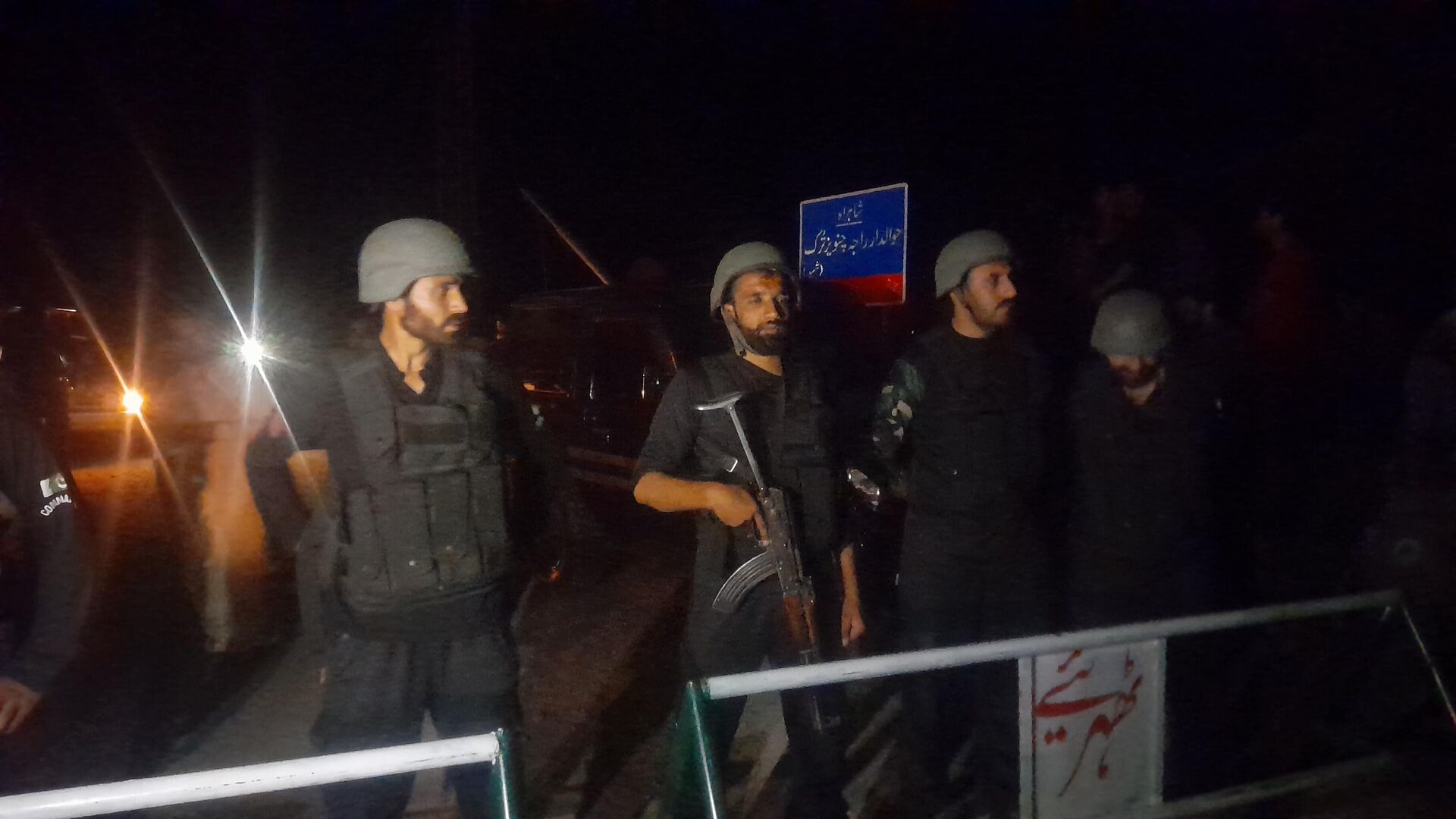https://sputniknews.in/20250513/operation-sindoor-osint-expose-pakistans-claims-of-victory-9117791.html
Operation Sindoor: OSINT Experts Expose Pakistan's Claims of Victory
Operation Sindoor: OSINT Experts Expose Pakistan's Claims of Victory
Sputnik India
Pakistan continues to claim victory over India in their recent military clash, despite evidence from Open Source Intelligence (OSINT) experts and satellite... 13.05.2025, Sputnik India
2025-05-13T20:49+0530
2025-05-13T20:49+0530
2025-05-14T12:19+0530
sputnik opinion
inter-services intelligence (isi)
sukhoi su-30mki
pakistan
india
islamabad
indian air force (iaf)
maxar technologies
indian army
pakistan army
https://cdn1.img.sputniknews.in/img/07e9/05/0d/9118507_0:0:3639:2047_1920x0_80_0_0_00cc02bb6a353325cd7d14cc591e0b88.jpg
After India launched Operation Sindoor in response to the heinous Pahalgam terrorist attack, Pakistan's military and leadership have engaged in a misinformation campaign against the Indian Armed Forces, frequently making unfounded claims and offering no evidence to support their assertions of successful operations against Indian counterparts.However, several OSINT handles quickly challenged their claims, showing how the Indian Air Force (IAF) carried out strikes deep inside Pakistan, damaging aircraft hangars, command and control centres, and radar installations.In addition, these analysts clarified that there was bare minimum damage to India's military installations, including airports and air bases in Adampur, Jammu, Udhampur, etc.For instance, Damien Symon, widely regarded as one of the most credible OSINT specialists, confirmed on social media that Pakistan's Rahim Yar Khan air base suffered extensive damage after the IAF struck more than a dozen military installations in Pakistan.Citing satellite pics released by US aerospace firm Maxar Technologies, Symon confirmed that many of Pakistan's air bases were damaged due to the IAF's precision strikes on these sites. He highlighted that the Rahim Yar Khan airfield had become inoperable following the Indian action.It is worth noting that Pakistan's Civil Aviation Authority (PCAA) had issued a Notice to Airmen (NOTAM) on Saturday evening, declaring its sole runway as non-operational for a week, literally accepting that India's airstrikes had destroyed some of the vital infrastructure there.Furthermore, destroyed hangars and craters in Pakistani Air Force (PAF) bases at Sargodha, Bholari, and Shahbaz in Jacobabad are also visible in Maxar's high-resolution images.Tom Cooper, an Austrian aerial warfare analyst and historian, declared that India "achieved a clear-cut victory" over Pakistan.Cooper suggests that, in addition to losing Air Defence systems, the PAF likely lost an F-16 in the aerial clash with the IAF, pointing to videos showing "two parachutes" and reports from civilians confirming "two parachutists". However, he noted that the mountainous area was quickly cordoned off by the ISI, leading to the swift removal of any evidence of the PAF’s loss.Decoding the Pakistani propaganda from Day 1 of Operation Sindoor, Anshuman Narang, a China scholar and an OSINT expert, highlighted in an interview with Sputnik India that Inter-Services Public Relations (ISPR), the media wing of the Pakistani military, was peddling lies.While Lt Gen Ahmed Sharif Chaudhry, the Pakistani military's spokesman, claimed that the IAF struck six sites across Pakistan and Pakistan-administered Kashmir, he pointed out that the IAF had actually targeted nine locations linked to terror infrastructure in the region.Another OSINT expert, who spoke to Sputnik India on the condition of anonymity, noted that Pakistan's propaganda campaign against India was busted much before the IAF dismantled almost all of their air bases, barring one.
https://sputniknews.in/20250513/decoding-the-efforts-to-diminish-s-400-and-brahmos-in-operation-sindoor-9110445.html
pakistan
india
islamabad
Sputnik India
feedback.hindi@sputniknews.com
+74956456601
MIA „Rossiya Segodnya“
2025
Pawan Atri
https://cdn1.img.sputniknews.in/img/07e6/0c/13/139630_147:0:831:684_100x100_80_0_0_8fa2b25903e7787fe6a2698552c167df.png
Pawan Atri
https://cdn1.img.sputniknews.in/img/07e6/0c/13/139630_147:0:831:684_100x100_80_0_0_8fa2b25903e7787fe6a2698552c167df.png
News
en_IN
Sputnik India
feedback.hindi@sputniknews.com
+74956456601
MIA „Rossiya Segodnya“
Sputnik India
feedback.hindi@sputniknews.com
+74956456601
MIA „Rossiya Segodnya“
Pawan Atri
https://cdn1.img.sputniknews.in/img/07e6/0c/13/139630_147:0:831:684_100x100_80_0_0_8fa2b25903e7787fe6a2698552c167df.png
inter-services intelligence (isi), sukhoi su-30mki, pakistan, india, islamabad, indian air force (iaf), maxar technologies, indian army, pakistan army
inter-services intelligence (isi), sukhoi su-30mki, pakistan, india, islamabad, indian air force (iaf), maxar technologies, indian army, pakistan army
Operation Sindoor: OSINT Experts Expose Pakistan's Claims of Victory
20:49 13.05.2025 (Updated: 12:19 14.05.2025) Pakistan continues to claim victory over India in their recent military clash, despite evidence from Open Source Intelligence (OSINT) experts and satellite imagery suggesting otherwise.
After India launched Operation Sindoor in response to the heinous Pahalgam terrorist attack, Pakistan's military and leadership have engaged in a misinformation campaign against the Indian Armed Forces, frequently making unfounded claims and offering no evidence to support their assertions of successful operations against Indian counterparts.
However, several OSINT handles quickly challenged their claims, showing how the Indian Air Force (IAF) carried out strikes deep inside Pakistan, damaging aircraft hangars, command and control centres, and radar installations.
In addition, these analysts clarified that there was bare minimum damage to India's military installations, including airports and air bases in Adampur, Jammu, Udhampur, etc.
For instance,
Damien Symon, widely regarded as one of the most credible OSINT specialists, confirmed on social media that Pakistan's
Rahim Yar Khan air base suffered extensive damage after the IAF struck more than a dozen military installations
in Pakistan.Citing satellite pics released by US aerospace firm Maxar Technologies, Symon confirmed that many of Pakistan's air bases were damaged due to the IAF's precision strikes on these sites. He highlighted that the Rahim Yar Khan airfield had become inoperable following the Indian action.
It is worth noting that Pakistan's Civil Aviation Authority (PCAA) had issued a Notice to Airmen (NOTAM) on Saturday evening, declaring its sole runway as non-operational for a week, literally accepting that India's airstrikes had destroyed some of the vital infrastructure there.
"Imagery released by MAXAR spotlights damage at Pakistan's Rahim Yar Khan airfield — the Indian Air Force strike showcases runway denial capability, an approximate 6-metre wide crater reveals the exposed subgrade layer rendering the strip inoperable," Symon said in a post on X.
Furthermore, destroyed hangars and craters in Pakistani Air Force (PAF) bases at Sargodha, Bholari, and Shahbaz in Jacobabad are also visible in Maxar's high-resolution images.
Tom Cooper, an Austrian aerial warfare analyst and historian, declared that India "achieved a clear-cut victory" over Pakistan.
"No surprise Islamabad 'sounded' for a cease-fire," he stated on social media. "With at least two of PAF's HQ-9s knocked out two days earlier, and the PAF suppressed enough to stop shooting PL-15s into the Indian airspace, in a matter of three hours the IAF Su-30MKI-, Mirage 2000- and Rafale-crews found enough opportunities to deliver a few really heavy blows. After this series of blows, the writing was on the wall: pending the IAF exhausting its stocks of Brahmos and SCALP-EGs, Pakistan had nothing left to counter these."
Cooper suggests that, in addition to losing Air Defence systems, the PAF likely lost an F-16 in the aerial clash with the IAF, pointing to videos showing "two parachutes" and reports from civilians confirming "two parachutists". However, he noted that the mountainous area was quickly cordoned off by the ISI, leading to the swift removal of any evidence of the PAF’s loss.
Decoding the Pakistani propaganda from Day 1 of Operation Sindoor, Anshuman Narang, a China scholar and an OSINT expert, highlighted in an interview with Sputnik India that Inter-Services Public Relations (ISPR), the media wing of the Pakistani military, was peddling lies.
While Lt Gen Ahmed Sharif Chaudhry, the Pakistani military's spokesman, claimed that the IAF struck six sites across Pakistan and Pakistan-administered Kashmir, he pointed out that the IAF had actually targeted nine locations linked to terror infrastructure in the region.
"The claims Pakistan made about flying drones over Delhi were nothing but fake, as nothing of that sort ever happened. However, it doesn't mean that they did not attempt such an action, but they proved futile as India's air defence blocked them right at the border," Narang stressed.
Another OSINT expert, who spoke to Sputnik India on the condition of anonymity, noted that Pakistan's propaganda campaign against India was busted much before the IAF dismantled almost all of their air bases, barring one.
"With the Pakistani military making hilarious statements like India sending drones to attack its own cities, Amritsar being one of them, it was completely exposed in front of everyone, including the international media. That is the reason, perhaps nobody believes them, not even their countrymen," the analyst remarked.



